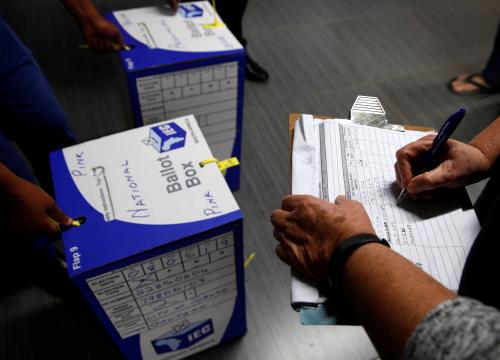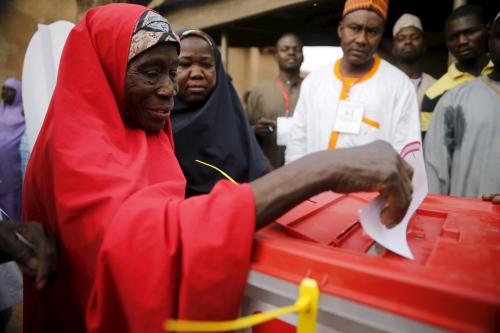Latin America is starting off 2015 with a clear economic slowdown. The United Nations Economic Commission for Latin America and the Caribbean (ECLAC) projects a modest recovery (2.2 per cent) with respect to last year (in 2014 growth was only 1.1 per cent, the lowest since the 2009 crisis), though these calculations may vary due to several factors.
The world economy is not helping. The downward trend in raw materials prices, scant dynamism in global demand, and the appreciation of the dollar are three factors that work against the region today.
Venezuela and Argentina, are facing very complex economic contexts. Venezuela is in the midst of stagflation (aggravated by plummeting oil prices); and Argentina is experiencing negative growth, high inflation, and the unresolved conflict with the “vulture funds.”
The two largest economies of the region, Brazil and Mexico, are facing their own demons. Brazil President Dilma Rousseff, with a weak mandate, is gambling the political capital of her second term (which just began on 1 January) on the new economic team led by Joaquim “Scissorhands” Levy. Levy is to make a fiscal adjustment that has been put off and is much needed; Rousseff hopes it will enable her to regain investor confidence, and thereby return to higher growth. The Petrobras scandal (in addition to the negative impact it has been having within the Workers Party) requires that she wage a head-on struggle against corruption and impunity (she just proposed a national anticorruption campaign), and that she implement a thoroughgoing political reform, which has been put off for too long.
In Mexico, falling oil prices, economic growth below official expectations, and the wave of protests in the wake of the murders of the 43 students in school to become teachers at Ayotzinapa, have eclipsed the so-called Mexico moment and have Enrique Peña Nieto against the ropes. He has sought to retake the initiative by announcing new reforms and proposals, and he hopes to recover citizen trust if the structural reforms yield the results promised.
The challenge of the polls
In the 2015 electoral agenda, of special note are three presidential elections (Argentina, Guatemala, and Haiti), three legislative elections (El Salvador, Mexico, and Venezuela), and several state, regional, and municipal elections, in Bolivia, El Salvador, Colombia, Mexico, Paraguay, and Uruguay, among others.
The three presidential elections continue to be very open races. In Guatemala (from the return of democracy to date) the party in power has never been returned to office. The three best-positioned presidential candidates are the government party candidate Alejandro Sinibaldi, and opposition candidates Manuel Baldizón (for now he’s leading the polls) and former first lady Sandra Torres.
In Argentina, kirchnerismo is pulling into the election period worn down and without any clear candidate for now. The three leading candidates based on polling data are Peronists Daniel Scioli (former vice president of Néstor Kirchner and current governor of the province of Buenos Aires) and Sergio Massa (former chief of staff of Cristina Fernández de Kirchner, currently a federal legislator and opponent of the government), and on the center-right Mauricio Macri (current head of government of the city of Buenos Aires).
In Haiti, in a tense political environment, it is not clear who will succeed President Michel Martelly, or what the exact date will be for municipal, legislative, or presidential elections. It is rumored that presidential elections may be held in January 2016. Ultimately the electoral calendar will depend on how negotiations proceed between Martelly and the opposition.
The Salvadoran legislative and municipal elections are especially important. The Sánchez Cerén administration will seek to revalidate its triumph of early 2014, ensuring good legislative and municipal support for his efforts with a view to the next three years, while the Alianza Republicana Nacionalista (ARENA) will seek to turn things around at the polls.
In Mexico, the future of the administration of President Peña Nieto, beset by protests and scandals, turns on the midterm elections of June 2015. Whether Peña Nieto will have sufficient political capital to continue giving impetus to his agenda of structural reforms (“Pacto por México”) during the remaining three years of his term will hinge on the results of these elections.
In Venezuela, the legislative elections will increase political tension and repression by the regime. The opposition has a golden opportunity to win back the legislative majority from the chavistas or President Chavez followers, taking advantage of the profound economic crisis looming over the country and the fall in Nicolás Maduro’s popularity in the polls. The big question is whether the opposition will prove capable of taking advantage of this opportunity and whether the elections will be truly free and competitive. The other aspect to monitor is whether Vatican diplomacy, under the leadership of Pope Francis (and with the precedent of the re-establishment of relations between the United States and Cuba in his favor), will be able to facilitate an effective political dialogue between the government and the opposition to seek a negotiated solution to Venezuela’s complex situation.
Colombia, Cuba and Chile
In Colombia, in addition to the regional elections (in which the uribistas, or followers of former President Álvaro Uribe, will seek to come out on top this time), attention is focused on the final phase of the negotiations in Havana between the Revolutionary Armed Forces of Colombia (FARC) and the government of Juan Manuel Santos aimed at achieving peace. If the negotiations are successful, it will no doubt be the most important political event in the region in 2015. The fate of the peace process will be subject to a referendum, which will probably be held in the second half of 2015 or early 2016 (depending on the speed at which the negotiations proceed and their success).
The most important political event of 2014–the re-establishment of diplomatic relations between the United States and Cuba after more than 50 years of confrontation–will continue to capture considerable attention in 2015. This decision, which entails a 180-degree turnabout in U.S. policy to Cuba, will help improve relations between the United States and the region. It enables Cuba to fully assume its place in the hemisphere (its participation at the Seventh Summit of the Americas next April in Panama will make it a historic occasion), and at the same time it will also be able to diversify its trade relations and allow for new investment at a time when Venezuela (its main partner in recent years) is experiencing its own profound economic crisis. Full normalization of relations between the United States and Cuba (including the end of the embargo, a decision in the hands of Congress) will be a long and complex process, but the first step has already been taken, and in the right direction. In 2015 it will also be important to monitor the evolution and results of the economic reforms that Raúl Castro has been carrying out.
In addition, 2015 is a vital year in Chile for the government of Michelle Bachelet who, with markedly diminished popularity and mounting criticism of her presidency, must address two major challenges in the second year of her administration: bringing about the recovery of an economy that has clearly slowed down (1.7 per cent during 2014), and continuing to give impetus to an ambitious agenda of reforms.
This year the polemical education reform should be approved; it not only enjoys the backing of the opposition, but also provokes major tensions within the government coalition. In addition, the electoral reform should be unveiled (it will do away with the binomial system) and the labour reform, which is resulting in a new distancing of business from the government. Another point on the agenda is starting up the process aimed at amending the Constitution (one of Bachelet’s three main pledges during her campaign); the process promises to be the “mother of all reforms.”
Different scenarios in regional relations
In regional relations, seven events stand out for their importance and should be closely monitored:
- The first ministerial meeting of China-Comunidad de Estados Latinoamericanos y Caribeños CELAC Forum in Beijing, China (January 8 and 9);
- The third meeting of CELAC in Costa Rica (January 28 and 29), where Ecuador will assume the presidency;
- The Seventh Summit of the Americas, which will take place in Panama (April 10 and 11), and whose focus of attention will be Cuba’s participation for the first time since the Summits process began in 1994;
- The election of a new Secretary General of the Organization of American States (OAS) with the capacity to strategically reposition this weakened regional organization affected by the political divisions among its member countries;
- The evolution of the process of rapprochement between MERCOSUR and the Pacific Alliance;
- The EU-Latin America Summit;
- The recent re-launch of UNASUR (which took place in December in Quito), under the leadership of former President Ernesto Samper.
My opinion
Latin America finds itself in the doldrums, and must undertake a two-fold transition: from the model based on high raw materials prices and low financing costs, to one with low raw materials prices and higher financing costs. As the OECD rightly notes: “this abrupt economic slowdown is not a passing phenomenon, it has come to stay. It’s the end of a cycle.”
This requires the region to urgently set in motion profound structural reforms, aimed at changing its development model which can strategically adapt to this new global context.
Only by improving productivity and competitiveness, education and innovation, infrastructure, but also the quality of its institutions, will the region be able to achieve inclusive, equitable, and sustainable economic growth that makes it possible to continue reducing poverty and inequality. All this will enable the region to respond more effectively to the demands and expectations of citizens ever more aware and demanding of their rights and of quality public services.
This economic slowdown and the implementation of an agenda of structural reforms (including the structural adjustment policies that we’ll see in some countries) will surely affect certain interests, thereby paving the way for certain countries to suffer greater social discontent in 2015 and a more complex situation when it comes to governability.
Yet the region is not homogenous. On the contrary, there is a considerable degree of heterogeneity that will determine a wide diversity of national situations. In effect, while Central America grew 3.7 per cent in 2014, and will grow 4.1 per cent in 2015, in South America these percentages are 0.7 per cent and 1.8 per cent respectively. Yet there is also diversity among countries. Accordingly, for example, while Panama (7.0 per cent), Bolivia (5.5 per cent), Peru, Dominican Republic, and Nicaragua (5.0 per cent) head up the list of economies with the best prospects for growth. Countries such as Brazil and Argentina – with more capacity for traction than the rest of the economies – have much more moderate projections. Mexico and Chile, predicted to experience 3 per cent annual growth, could help push the regional average up. Venezuela, similar to 2014 (with negative growth and inflation at about 64 per cent), will have a very complicated year economically speaking.
As Warren Buffet said, and rightly so, “when the tide goes out you can see who’s been skinny dipping.” Something similar will happen with the countries of the region in 2015. Soon we’ll know which governments have been financially exposed.
This piece was originally published by
International IDEA
.


Commentary
Op-edLatin America 2015: Time for Reform
January 9, 2015